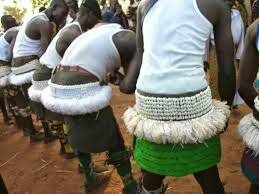Some other clans (Tambiouk, Maab, Bakpang and Tont) came, according to oral history, from the area that is presently known as south Togo and the Southern regions of Ghana (Ashanti en Dagomba land).
According to Fuzzy (1979), the Mobas migrated south from Feda Ngourma in Burkina Faso towards the end of the 17th century, then they were driven north by the Mamprusis and Dagombas using Chokosi mercenaries, to the part of the country that they now inhabit. They mingled with Bems and groups of Mamprusis and Konkombas to form the Bimoba people.
Assimeng (1990) states that the Bimoba comprising three different clan groups, all deriving from the same stock – Bem, Mɔba, and Dagbaan – migrated southward from Nung in what is now Burkina Faso, but he also describes other possibilities. At the time they were effectively occupying their present homeland, and the British and Germans were extending their spheres of influence. The Bimoba were in the "neutral zone" established by the colonial powers in 1888; the Anglo-German convention of 1899 finally drew the international border to the west of their territory, placing the Mɔab under German rule. However after World War I Britain and France divided former German Togo between them, and established the present border which divides Mɔakuni between Ghana and Togo.
All written sources are clear about the fact that the Bimoba tribe is a combination of different smaller groups, although the combination of clans is different in each and every source (Bims, Moba and Daggams or Moba, Basaalis, Gurmas, and Kokombas).
Bimoba society is patriarchal and is structured around clan and family heads. There are Clan-based kings or chiefs with vested power to hold the various clans together. The clans themselves can be located on multiple locations based on power and numbers. Presently, the clan groups of the Bimoba include Luok, Gnadaung, Dikperu, Puri, Tanmung, Gbong, Labsiak, Kunduek, Buok, the Baakpang, Turinwe and Kanyakib
Moba or Moba–Bimoba is a major language of the Moba people of Togo and Ghana. However, in Ghana only 60% of ethnic Bimoba speak the language. There are also about 2,000 Moba speakers in Burkina Faso. It has two dialects (Moba In Togo and Burkina Faso and Bimoba in Ghana). The language cluster is also known as Moba–Bimoba.
Moba is spoken by the Moba people, a subgroup of the Gurma people. Moba is part of the Gurma subgroup of the Gur languages. It is related to the Konkomba language of the Konkomba people.
| a | b | c | d | e | ɛ | f | g | gb | h | i | j | k | kp | l |
| m | n | ny | ŋ | ŋm | o | ɔ | p | r | s | t | u | w | y |
The Bimoba practice predominantly ethnic religions. They identify with personal deities collectively referred to as Yennu, which translates as "god" or "sun". Their ancestors play a role by being the contact between themselves and Yannu. A typical Bimoba compound would have a clay construction altar (patir; plural: pataa) in an enclosed hut (nakouk) where sacrifices are made to invoke the presence of the ancestors. Women are allowed into the nakuuk. Aside the patir located in the compound, every family member is allowed to construct their own small altar known as a mier. Communities may have a common shrine known as tingban. The tingban is visited at times of problems that concern the entire community such as a drought or a disease outbreak.
KEEP READING OURARTICLES @ INFO CORNER---FOLLOW US NOW


